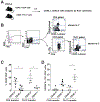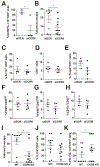Distinct characteristics of hippocampal pathogenic TH17 cells in a mouse model of depression
- PMID: 29698707
- PMCID: PMC6287768
- DOI: 10.1016/j.bbi.2018.04.012
Distinct characteristics of hippocampal pathogenic TH17 cells in a mouse model of depression
Abstract
Increasing evidence indicates that multiple actions of the immune system are closely intertwined with the development of depression and subsequent recovery processes. One of these interactions is substantial evidence that the TH17 subtype of CD4+ T cells promotes susceptibility to depression-like behaviors in mice. Comparing subtypes of CD4+ T cells, we found that administration of TH17 cells, but not TH1 cells or TREGS, promoted susceptibility to learned-helplessness depressive-like behavior and accumulated in the hippocampus of learned helpless mice. Adoptively transferred TH17 cells into Rag2-/- mice that are devoid of endogenous T cells increased susceptibility to learned helplessness, demonstrating that increased peripheral TH17 cells are capable of modulating depression-like behavior. Moreover, in wild-type mice, adoptively transferred TH17 cells accumulated in the hippocampus of learned-helpless mice and induced endogenous TH17 cell differentiation. Hippocampal TH17 cells from learned-helpless mice expressed markers of pathogenic TH17 cells (CCR6, IL-23R) and of follicular cells (CXCR5, PD-1), indicating that the hippocampal cells are TFH-17-like cells. Knockout of CCR6 blocked TH17 cells from promoting learned helplessness, which was associated with increased expression of PD-1 in CCR6-deficient TH17 cells. In summary, these results reinforce the conclusion that depression-like behaviors are selectively facilitated by TH17 cells, and revealed that these cells in the hippocampus of learned helpless mice display characteristics of TFH17-like cells, which may contribute to their pathogenic actions in promoting depression.
Keywords: Depression; Th17.
Copyright © 2018 Elsevier Inc. All rights reserved.
Conflict of interest statement
Financial disclosures
The authors have no financial interests or conflicts of interest.
Figures








Comment on
-
Inflammatory T helper 17 cells promote depression-like behavior in mice.Biol Psychiatry. 2013 Apr 1;73(7):622-30. doi: 10.1016/j.biopsych.2012.09.021. Epub 2012 Nov 20. Biol Psychiatry. 2013. PMID: 23174342 Free PMC article.
References
-
- Acosta-Rodriguez EV, Rivino L, Geginat J, Jarrossay D, Gattorno M, Lanzavecchia A, Sallusto F, and Napolitani G (2007). Surface phenotype and antigenic specificity of human interleukin 17-producing T helper memory cells. Nat Immunol 8, 639–646. - PubMed
Publication types
MeSH terms
Grants and funding
LinkOut - more resources
Full Text Sources
Other Literature Sources
Medical
Research Materials
Miscellaneous

